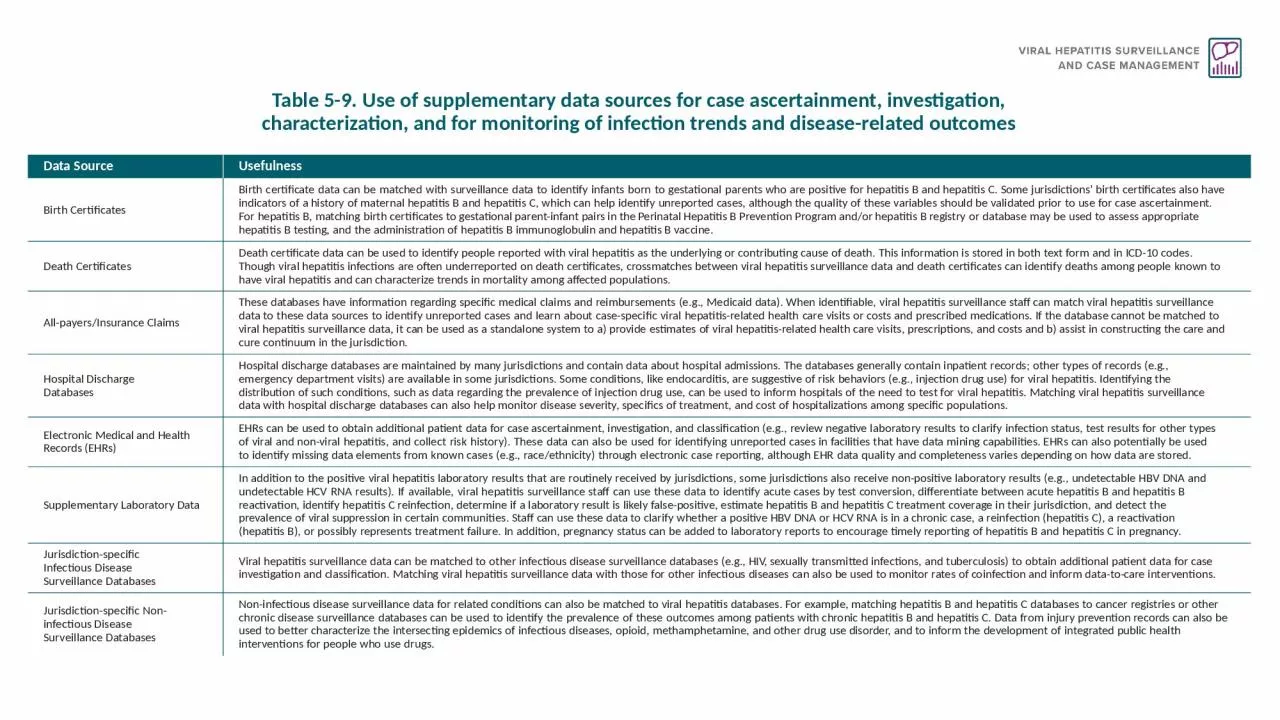

Data Source Usefulness Birth Certificates Birth certificate data can be matched with surveillance data to identify infants born to gestational ID: 1009238
Download Presentation The PPT/PDF document "Table 5-9. Use of supplementary data sou..." is the property of its rightful owner. Permission is granted to download and print the materials on this web site for personal, non-commercial use only, and to display it on your personal computer provided you do not modify the materials and that you retain all copyright notices contained in the materials. By downloading content from our website, you accept the terms of this agreement.
1. Table 5-9. Use of supplementary data sources for case ascertainment, investigation, characterization, and for monitoring of infection trends and disease-related outcomesData SourceUsefulnessBirth CertificatesBirth certificate data can be matched with surveillance data to identify infants born to gestational parents who are positive for hepatitis B and hepatitis C. Some jurisdictions’ birth certificates also have indicators of a history of maternal hepatitis B and hepatitis C, which can help identify unreported cases, although the quality of these variables should be validated prior to use for case ascertainment. For hepatitis B, matching birth certificates to gestational parent-infant pairs in the Perinatal Hepatitis B Prevention Program and/or hepatitis B registry or database may be used to assess appropriate hepatitis B testing, and the administration of hepatitis B immunoglobulin and hepatitis B vaccine.Death CertificatesDeath certificate data can be used to identify people reported with viral hepatitis as the underlying or contributing cause of death. This information is stored in both text form and in ICD-10 codes. Though viral hepatitis infections are often underreported on death certificates, crossmatches between viral hepatitis surveillance data and death certificates can identify deaths among people known to have viral hepatitis and can characterize trends in mortality among affected populations.All-payers/Insurance ClaimsThese databases have information regarding specific medical claims and reimbursements (e.g., Medicaid data). When identifiable, viral hepatitis surveillance staff can match viral hepatitis surveillance data to these data sources to identify unreported cases and learn about case-specific viral hepatitis-related health care visits or costs and prescribed medications. If the database cannot be matched to viral hepatitis surveillance data, it can be used as a standalone system to a) provide estimates of viral hepatitis-related health care visits, prescriptions, and costs and b) assist in constructing the care and cure continuum in the jurisdiction.Hospital Discharge DatabasesHospital discharge databases are maintained by many jurisdictions and contain data about hospital admissions. The databases generally contain inpatient records; other types of records (e.g., emergency department visits) are available in some jurisdictions. Some conditions, like endocarditis, are suggestive of risk behaviors (e.g., injection drug use) for viral hepatitis. Identifying the distribution of such conditions, such as data regarding the prevalence of injection drug use, can be used to inform hospitals of the need to test for viral hepatitis. Matching viral hepatitis surveillance data with hospital discharge databases can also help monitor disease severity, specifics of treatment, and cost of hospitalizations among specific populations.Electronic Medical and Health Records (EHRs)EHRs can be used to obtain additional patient data for case ascertainment, investigation, and classification (e.g., review negative laboratory results to clarify infection status, test results for other types of viral and non-viral hepatitis, and collect risk history). These data can also be used for identifying unreported cases in facilities that have data mining capabilities. EHRs can also potentially be used to identify missing data elements from known cases (e.g., race/ethnicity) through electronic case reporting, although EHR data quality and completeness varies depending on how data are stored.Supplementary Laboratory DataIn addition to the positive viral hepatitis laboratory results that are routinely received by jurisdictions, some jurisdictions also receive non-positive laboratory results (e.g., undetectable HBV DNA and undetectable HCV RNA results). If available, viral hepatitis surveillance staff can use these data to identify acute cases by test conversion, differentiate between acute hepatitis B and hepatitis B reactivation, identify hepatitis C reinfection, determine if a laboratory result is likely false-positive, estimate hepatitis B and hepatitis C treatment coverage in their jurisdiction, and detect the prevalence of viral suppression in certain communities. Staff can use these data to clarify whether a positive HBV DNA or HCV RNA is in a chronic case, a reinfection (hepatitis C), a reactivation (hepatitis B), or possibly represents treatment failure. In addition, pregnancy status can be added to laboratory reports to encourage timely reporting of hepatitis B and hepatitis C in pregnancy.Jurisdiction-specific Infectious Disease Surveillance DatabasesViral hepatitis surveillance data can be matched to other infectious disease surveillance databases (e.g., HIV, sexually transmitted infections, and tuberculosis) to obtain additional patient data for case investigation and classification. Matching viral hepatitis surveillance data with those for other infectious diseases can also be used to monitor rates of coinfection and inform data-to-care interventions.Jurisdiction-specific Non-infectious Disease Surveillance DatabasesNon-infectious disease surveillance data for related conditions can also be matched to viral hepatitis databases. For example, matching hepatitis B and hepatitis C databases to cancer registries or other chronic disease surveillance databases can be used to identify the prevalence of these outcomes among patients with chronic hepatitis B and hepatitis C. Data from injury prevention records can also be used to better characterize the intersecting epidemics of infectious diseases, opioid, methamphetamine, and other drug use disorder, and to inform the development of integrated public health interventions for people who use drugs.